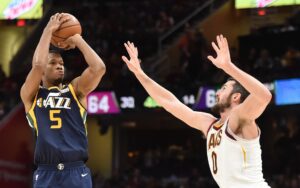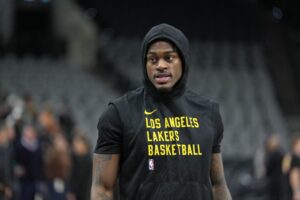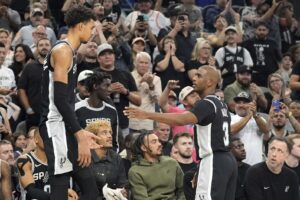The NCAA tournament is filled with electric personalities and dominant performers. Now, while many of these players fade into obscurity after their collegiate careers come to a close, a select few go on to stardom at the next level. So, keeping that in mind, let’s take a look at the most notable NBA players from each Elite Eight team.
Each Elite Eight Team’s Best NBA Player
Michigan: Chris Webber
Who could forget the Fab Five? The group of starting Michigan freshmen, led by Chris Webber, electrified the nation and inspired youngsters across the country to don black socks and baggy shorts. But it wasn’t just the style that made Webber such a special talent. The first team All-American was a terror in the Big Ten, using his 6’9″ frame to bully opposing big men on a nightly basis. He helped lead the Wolverines to back-to-back national championship game appearances, but unfortunately (due to a regrettable timeout call) was never able to deliver a title to Ann Arbor.
Webber easily carried over his success at the collegiate level to the pros. He was the No. 1 overall selection in the 1993 Draft and went on to play 15 years in the league. During that time, he was selected to five NBA All-Star games, averaging 20.7 PPG and 10.0 RBG over the course of his career. The Sacramento Kings retired C-Webb’s number in 2009 and he is currently a 2018 finalist for the NBA Hall of Fame.
Kansas State: Mitch Richmond
Mitch Richmond has his name and number hanging from the rafters at Kansas State’s Bramlage Coliseum. Though he spent only two years in Manhattan, Richmond was able to create a lasting legacy. Richmond led the Wildcats to consecutive NCAA Tournament appearances in the late ’80s, taking them as far as the Elite Eight before being upset by the eventual national champion, the Kansas Jayhawks, in 1988. The guard scored 1,327 points during his tenure, which still holds as the KSU record over a two-year career.
Following those explosive two seasons, Richmond began an illustrious pro career after he was selected No. 5 overall in the 1988 NBA Draft by the Golden State Warriors. And the train didn’t stop rolling there. The sharpshooter would go on to be named Rookie of the Year, get selected to six All-Star games, and win both an NBA title and an Olympic gold medal. It was no surprise that he was selected to the NBA Hall of Fame in 2014.
Loyola, Chicago: LaRue Martin
Although Sister Jean and the Ramblers have captured the hearts of the nation, they haven’t been spoiled by great talent in the past. Needless to say, there weren’t too many players to pick from. As a result, I went with LaRue Martin, who enjoyed plenty of success while in college. Over his three-year career, not only did Martin stifle Bill Walton, but he also put up preposterous numbers. To be exact, he had career averages of 18.2 points and 15.9 rebounds per game.
Surprisingly, the Portland Trail Blazers selected Martin No. 1 overall in the 1972 draft – bringing on expectations that he would never quite live up to. In fact, it’s entirely possible that Martin originated the “bust” classification among highly-touted prospects. The 6’11” center would enjoy only a four-year career in the association, where he averaged 5.3 points and 4.6 rebounds.
Florida State: Dave Cowens
Although Dave Cowens may not be a household name to the younger generation of basketball fans, that shouldn’t take away from his impressive resume. The 6’9” forward was a tenacious rebounder and scorer while at Florida State. He averaged 19.0 points over his collegiate career, to go along with an astounding 17.2 rebounds. Those numbers not only put him on all kinds of FSU “All-Time” lists but also cemented him a spot in the College Basketball Hall of Fame.
Cowens had no trouble carrying over his dominance to the next level. He played 10 of his 11 seasons with the Boston Celtics and took home two titles as a result. The big man earned the MVP award in the 1972-73 season and made a total of eight All-Star games. Not only was he honored by being named to the Naismith Hall of Fame, but he was also named one of the 50 Greatest Players in NBA History during the NBA’s 50th anniversary in 1996.
Duke: Grant Hill
Grant Hill was the poster boy for college basketball in the early 1990s. He did it all on both ends of the floor alongside Christian Laettner and Bobby Hurley. The trio would win back-to-back national titles at Duke in the 1991 and 1992 seasons. And while Laettner got a lot of the media attention, Hill’s accomplishments were nothing to scoff at. He garnered All-American honors twice, won a Defensive Player of the Year, and took home the ACC Player of the Year award in 1994.
Unfortunately for Hill, injuries plagued much of his impressive NBA career. After the Detroit Pistons picked him No. 3 overall in 1994, Hill went on to play 19 years at the next level. Throughout that long ride, he made seven All-Star teams and earned All-NBA honors numerous times. He also took home the NBA Sportsmanship Award on three separate occasions. Hill already holds a spot in the College Basketball HOF and is currently a finalist for the NBA’s Hall of Fame as well. It leaves many to wonder just how legendary Hill could’ve been had his body held up.
Villanova: Paul Arizin
Like Cowens, many folks may not be familiar with legendary Villanova Wildcat, Paul Arizin. That’s most likely because the 6’4″ Philadelphia native played a lifetime ago, in the 1950s and ’60s. While at ‘Nova, however, Arizin was a phenom. Not only did the forward with a National Player of the Year trophy, but he also once scored 85 points in a single game. Surely enough, the Philadelphia Warriors selected Arizin with the No. 5 overall pick in the 1950 NBA Draft.
While in Philly, Arizin continued to enjoy a plethora of success. Even though he had to sit out two seasons to serve in the Korean War, Arizin still managed to turn in an astounding career. Some of his accolades include being a 10-time All-Star, two-time scoring champion, one-time NBA champion, and being listed on both the 25th and 50th NBA Anniversary top players lists. Arizin is undoubtedly one of the greatest players in league history and should be revered for his military service as well.
Kansas: Wilt Chamberlain
The Kansas Jayhawks’ pick for this list needs no introduction. Wilt Chamberlain is not only one of the greatest NBA players ever, but he was no slouch in college, either. During his two years in Lawrence, Chamberlain averaged 29.9 points and 18.3 rebounds. He also delivered on his promise to bring a Big 7 Title to Kansas in 1957. Unfortunately, the team’s lost its title hopes in the Final Four later that year, but Chamberlain was still named the Most Outstanding Player. He was inducted into the College Basketball Hall of Fame in 2009.
There isn’t enough space to list all of Chamberlain’s achievements. To go along with being the only player to score 100 points in a single game, Chamberlain was a four-time NBA MVP, two-time NBA Champion, seven-time scoring champion, 11-time rebounding champion, and the list goes on for an eternity. I mean, the guy once averaged 50.4 points for an entire season. That’s super-human type stuff. When people converse about who the “GOAT” is, Chamberlain’s name certainly must be near the top of the list.
Texas Tech: Geoff Huston
Geoff Huston is definitely another head-scratcher on this list. Texas Tech, like Loyola, doesn’t have many legendary ballers to pick from. Therefore it was a toss-up between the 6’2″ guard and his polar opposite, Tony Battie. “Silk,” as Huston was nicknamed, played four seasons with the Red Raiders from 1975-1979. Over the course of his career, he averaged a moderate 9.1 points per game. From there, it was off to the NBA, by way of the third round of the 1979 draft.
Huston played in 496 games at the pro level with five different teams. He never really managed to make a lasting impact at any stop he made. During his time in the league, Huston averaged a quality 8.8 points and 5.1 assists while bouncing back and forth from a starter to a reserve role. Surely, an electric Texas Tech player will make an impact at the next level soon, but until then, Huston is carrying the torch.
Main Photo:
Embed from Getty Images






